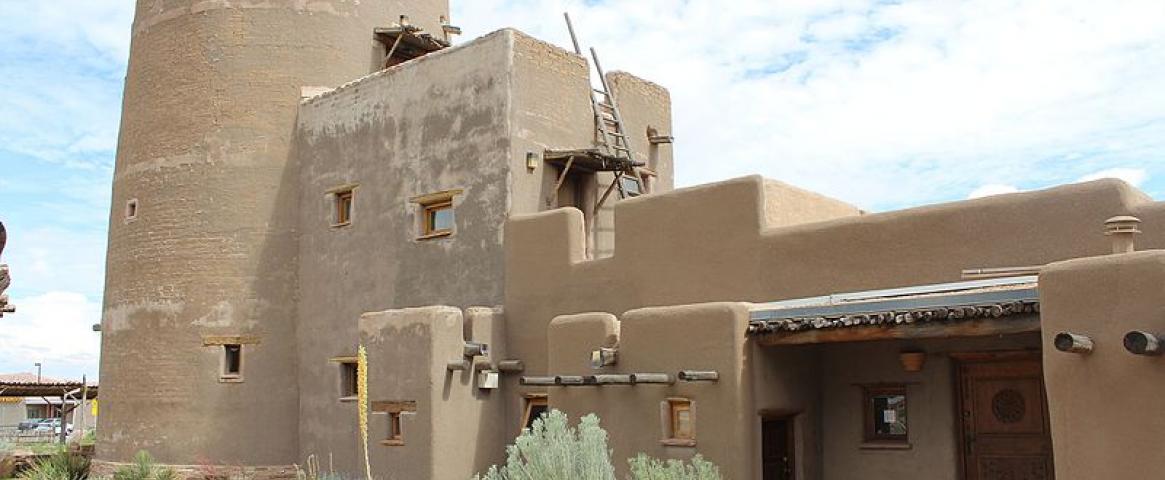By Annabelle Moore
Amidst the piñon trees and dusty-green sagebrush on high desert mesas north of Santa Fe, New Mexico, Tewa (Tay-wah) elders and youth meet with anthropologists and students for a ‘slow talk’ around the ancestral village of K’uuyemugeh (Koo-yeh-muhn-geh). They’re creating a new working relationship grounded in mutual respect. This shared partnership takes cultural responsibility by using scientific tools, multi-vocal traditional Tewa knowledge and modern technology to recover the lost history of the Pueblo of Pojoaque (Poh-wah-key).

The ongoing partnership, described in a recent issue of Advanced Archaeological Practice, began in 2014 when the pueblo invited ethnologist Bruce Bernstein to become the Tribal Historic Preservation Officer and create a cultural land heritage program. Bernstein brought in Scott Ortman, an archaeologist with the University of Colorado Boulder, to help design a multi-vocal community-based surface archaeology project.
“[Archaeology] projects that occurred in the ‘50s were done very destructively,” says Adam Duran, Tribal War Chief for the Pueblo of Pojoaque. “What we’re wanting to do is go in the opposite direction.” This project achieves that goal, says Duran, because “they want us to have the information. They [won’t] keep it like they did in the past.”
The Native American Graves Protection and Repatriation Act in 1990 initiated many changes in how U.S. archaeology projects are designed and conducted, says Ortman, and an engaged partnership takes the next step. The “lines of inquiry for the surveys and understanding K’uuyemugeh come from the community,” says Bernstein. A partnership model, he explains, asks, “How can we provide knowledge that will fit into the ongoing narrative in the community?”
Notes William White, an Assistant Professor of Anthropology at the University of California, Berkeley, who was not involved in the project, “It’s only recently that we’ve actually started to listen to what communities are saying and then to design our work around their needs, rather than [around] what we want to figure out.”
“Both parties were interested in learning about people in the past,” says Ortman. “The present-day community members are not research subjects, they’re collaborators—co-investigators.”

Tewa members shared migration histories on slow talks at K’uuyemugeh, giving archaeologists and students a unique perspective of village architecture, field houses, shrines, paths, and pottery sherds over time. It’s said that a small group of winter peoples arrived in the Tewa Basin by traveling south along the east side of the Rio Grande River and were later joined by a larger group of summer peoples traveling along the west side of the river. The two villages were later combined into one community.
An examination of pottery and construction patterns showed that a small group established K’uuyemugeh around 1150 AD and expanded into two villages between 1250 and 1400 AD. Homes and structures were built in a counter-clockwise spiral patternas the village’s population grew to 700. That physical evolution is reflected in the spiral pattern of surface pottery around K’uuyemugeh homes, as well as in the direction of Tewa dances.
The Spanish colonial conquests of the 1690s reduced its population to an estimated 100 people, and by 1706, the village was emptied. Pojoaque is now home to a native population of 500, and the pueblo reinstated cultural and ceremonial practices in 1970.
“I learned that Pojoaque may have been a central trading hub for outlying Tewa villages and other indigenous populations,” says Duran. “Having the collaboration ... opened our eyes to who we were at one time.”
The partners have shared their findings through community days at K’uuyemugeh, 3D models, drone aerial photography, and presentations at tribal council. One long-range goal is to establish a pueblo-owned database of artifacts and records.
It’s about building relationships,” says Michael Spears, a graduate student at the University of Arizona, who has helped digitalize thousands of archaeological records once stored in restricted access research laboratories. “Students will be steeped in new practices and learn to work with native voices.”
Project “design is key,” says Catherine Draycott, Assistant Professor of Archaeology at Durham University, who is not involved in the project, “You’re there as a service.”
Duran believes the ability to integrate science and culture has strengthened his ability to tell the pueblo’s story. “I look forward to [welcoming] more groups into the pueblo for ... the opportunity to get a firsthand perspective of what we’re trying to protect.”
Annabelle Moore is a graduate student in the Johns Hopkins University Master in Science Writing program. She has written for Undark, STEM and humanitarian non-profit blogs. She can be reached at ab.moore@protonmail.com.
This story was produced as part of NASW's David Perlman Summer Mentoring Program, which was launched in 2020 by our Education Committee. Moore was mentored by Jeffrey Mervis.



